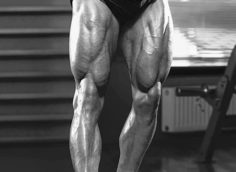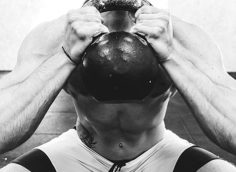Here's what you need to know...
- Having a ton of equipment is a double-edged sword. It sometimes makes you lazy and under-skilled in the gym.
- Free weights give you a lot of benefits that you just can't get from machines.
- Old-time bodybuilders were stronger than most of today's bodybuilders because they trained with free weights and used higher frequency.
- Lazy bodybuilders think they can't "feel" the muscles, get a good pump, or get the same kind of "squeeze" with free weights, but it's bullshit.
Before the Rise of the Machines

When I first started lifting in a small gym in Tel Aviv, Israel, 20 years ago, all we had to work with were a few barbells, some heavy dumbbells, a crooked adjustable bench press, and a chin up/dip bar. There wasn't a single machine in the place.
Already a T Nation+ Member? Log in
You haven’t completed your membership signup
Your T Nation+ membership has expired
Get instant access to this content
Become a T Nation+ member and get immediate access to all of our member-only videos, articles, coaching groups and more.
Click here to learn more about T Nation+Click here to complete the signup processClick here to renew your membership
That turned out to be a great stroke of luck for me as an athlete. By the time I was 19 years old I was already squatting 500 pounds, deadlifting 550, clean & jerking 400, and snatching 310.
I didn't have any other choice but to train hard with basic equipment. I was either going to lift heavy weights in all compound exercises or I wouldn't advance. All I did was squat, bench, press and pull. I never saw a leg curl machine, leg press, leg extension or any Hammer Strength or pin-loaded machines until years later.
I was training for strength and the best part was that I had huge shoulders, back, legs and traps without even trying. It was just a terrific side effect from lifting really heavy weight and doing compound movements.
That's How Arnold Did It
When you hear Arnold talk about how they trained in the old days, he describes 2 to 3-hour workouts done with barbells and dumbbells, partly because they didn't have all of this fancy equipment that they have today.
The guys back in the day arguably looked better and were most definitely stronger than most of today's bodybuilders. They also trained with higher frequency, often squatting twice a week and pressing three times a week.
Today, bodybuilders and strength athletes have a lot of equipment options. It's great, but it can be a double-edged sword.
While sometimes beneficial, all this equipment often makes you lazy and under-skilled in the gym. I usually see people choosing machines as an easy way out instead of doing a more appropriate free weight exercise.
I mean, c'mon, we all know the leg press is a much easier exercise than the squat, but people will convince themselves otherwise when it's a certainty they'd get better results from the squat.
Free weights give you a lot of great benefits that you just can't get from machines, including core stability, bigger and more natural ranges of motion, functional strength, overall stability, and oh yeah, bigger muscles!
Some of you lazy bodybuilders out there are probably thinking that you can't "feel" your muscles the same with free weights, or that you can't get a good pump or the same kind of "squeeze" with free weights, but I call bullshit on that.
Try a 5-second eccentric, a 2-3 second pause at peak contraction, or even a simple drop set with free weights and tell me that you can't get a pump or feel it.
Better yet, try my "No Machines" workout and rethink your whole relationship with machines!

The No-Machines Workout
This isn't a beginners program. You need to have a few good years of training under your belt and you need to know your 1RM in several lifts in order to perform the workouts.
You'll be going heavy once a week to imitate the fatigue and work of a meet and you'll concentrate on technique, speed, and accessory work on the other days.
This program is more strength related but you'll also experience great gains in hypertrophy. The frequency with which you'll hit each body part is high and will require proper workout nutrition and supplementation.
Recommend supplements for this program:
- Plazma™ – To preload anabolic nutrients, induce a pump effect, and stimulate rapid recovery.
- Mag-10® – To speed recovery from intense training and maximize the post-workout anabolic effect.
- Micro-PA™ – To activate muscle growth.
- Power Drive® – For neural activation and explosive power.
Lastly, respect the recovery weeks (4 & 8) because doing all three big lifts at 90-95% in one day will take a toll on your body. You'll need to take necessary measures and back off as advised.

Day 1 – Power Emphasis Day
During weeks 1, 2, 3, 5, 6, and 7, you'll do the competition squats, benches, and deadlifts at the percentages listed below.
- A. Competition Squat
- B. Competition Bench
- C. Competition Deadlift
- Weeks 1 & 5: 4-5 sets x 5-6 reps @ 70-75%
- Weeks 2 & 6: 4-5 sets x 3-4 reps @ 80-85%
- Weeks 3 & 7: 2-5 sets x 1-2 reps @ 90-95%
Weeks 4 and 8 are recovery weeks where you'll do three entirely different exercises (front squats, incline or decline presses, and sumo deadlifts) for the sets and reps listed below.
- A. Front Squat
- B. Incline or Decline Press
- C. Sumo or Conventional Deadlift *
- Weeks 4 & 8: 3 sets x 12/10/8 @ 60-65%
* The opposite of what you did in weeks 1-3.
Note the range in percentages. An intermediate level athlete would more likely start at the bottom of this range and a more advanced athlete could go with a higher percentage. It all depends on experience and level of training.
Day 2 – Light Shoulder & Triceps Day
| Exercise | Sets | Reps | |
|---|---|---|---|
| A | Standing Lateral Raise | 3 | 12-15 |
| B | Rear Delt Dumbbell Lateral | 3 | 20/20/dropset |
| Lying face down on incline bench do 3 sets x 20/20/dropset: 10/10/10 (do a set of 20, another set of 20, and then a drop set where you do 10 reps, drop the weight, do 10 more reps and drop the weight, and then 10 more reps.) | |||
| C | Seated Dumbbell Press * | 3 | 12 |
| D | Decline Skullcrusher * * | 3 | 12 |
| E | 1-Arm Dumbbell Overhead Extension | 3 | 12 + dropset |
| F1 | 1-Arm Incline Dumbbell Triceps L-Extension | 3 | 12 |
| F2 | Close-Grip Push-Up on Bench | 3 | To failure |
* The first 6 reps use a 3-second negative; the rest are done normally.
* * The first 6 reps use a 5-second negative.

Day 3 – Back & Biceps
| Exercise | Sets | Reps | |
|---|---|---|---|
| A | Weighted Pull-Up (neutral grip) * | 4 | 10/8/6/failure |
| B | Barbell or Trap Bar Row | 3 | 12/10/8 |
| C | Wide-Grip Bodyweight Pull-Up * * | 3 | 10-12 |
| D | 1-Arm Dumbbell Row * * * | 3 | 12 |
| E | Incline Dumbbell Curl * * * | 3 | 12 |
| F1 | Dumbbell Concentration Curl * * * | 3 | 10-12 |
| F2 | Hammer Curl | 3 | 10-12 |
* 4 sets x 10/8/6/bodyweight to failure.
* * Do them loaded if you can do more than 10-12 reps.
* * * The first 6 reps use a 5-second negative and the last 6 use a 2-second pause at peak contraction.
Day 4 – OFF
Day 5 – Accessory/Speed Squat & Deadlift Day
| Exercise | Sets | Reps | |
|---|---|---|---|
| A | Front Squat (60-70%) | 6 | 5 |
| B | Deficit Deadlift (60-70%) | 6 | 3 |
| C | Bulgarian Squat or Lunge (60-70%) | 3 | 8-10 |
| D | Rack Snatch Pull (70%) | 4 | 6 |
Day 6 – Accessory Bench & Shoulders
| Exercise | Sets | Reps | |
|---|---|---|---|
| A | Incline Bench Press | 4 | 10/8/8/6 |
| B | Close-Grip Bench Press | 3 | 10/8/6 |
| C | Standing Military Press | 3 | 10/8/6 |
| D1 | Decline Dumbbell Fly | 3 | 10 |
| D2 | Dumbbell Press * | 3 | 10 |
| E | Wide-Grip Bodyweight Dip | 2 | 12-15 |
* Use the same weight as you did on the fly.





